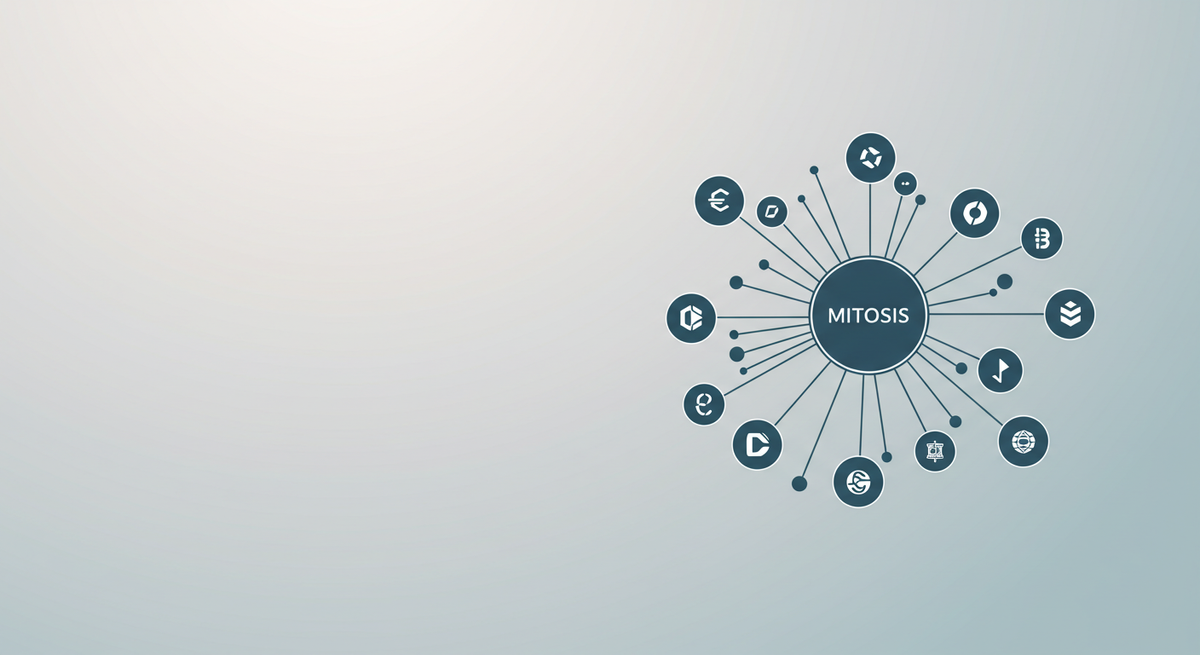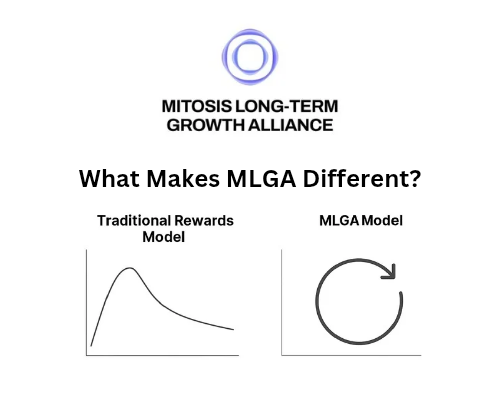Bridging the Gaps: How Mitosis EOL Unifies DeFi Liquidity

- Introduction
Let's start with an intriguing question: what if liquidity in decentralized finance (DeFi) could flow freely between blockchains, like water in a system of interconnected vessels? Today's DeFi reality, unfortunately, is more like a multitude of separate pools, each with its own water level (liquidity). This is the problem of liquidity fragmentation – the bane of modern DeFi, limiting growth, efficiency, and user experience.
Why is this topic important? Liquidity fragmentation leads to a number of negative consequences:
- Reduced capital efficiency: Users are forced to hold assets on different platforms to access the services they need, which reduces the overall efficiency of capital utilization.
- Increased slippage: When exchanging assets between blockchains, users often encounter high slippage – the difference between the expected price and the actual execution price of a trade.
- Complexity for developers: DeFi projects have to integrate with many different blockchains, which complicates development and maintenance.
- Limited choice for users: Users are limited in their choice of DeFi services available on a particular blockchain.
In this article, we will take a detailed look at how Mitosis, an innovative liquidity protocol, addresses this fundamental problem with its unique Ecosystem-Owned Liquidity (EOL) mechanism. You will learn:
- What EOL is and how it works.
- What specific benefits EOL provides to users and DeFi projects.
- How Mitosis contributes to the creation of a single, seamless DeFi space.
- How Mitosis solves the liquidity fragmentation problem, in a contrast to other protocols.
2. Main Content
2.1. What is Ecosystem-Owned Liquidity (EOL) and How Does it Work in Mitosis?
Traditional liquidity models in DeFi often rely on rented liquidity. This means that users provide their assets to liquidity pools (for example, on decentralized exchanges) in exchange for rewards. However, this liquidity is impermanent: users can withdraw their funds at any time, which creates a risk to the protocol's stability, especially during times of market volatility.
Mitosis offers a fundamentally different approach – Ecosystem-Owned Liquidity (EOL). Instead of relying solely on external liquidity providers, Mitosis creates and owns a significant portion of its liquidity. How is this achieved?
- Mitosis Treasury: The central element of EOL is the Mitosis Treasury. It accumulates assets in various ways, such as through a portion of transaction fees on the network, validator rewards, or strategic partnerships.
- Liquidity Deployment: The Mitosis Treasury deploys this liquidity across various blockchains and DeFi protocols where it is most needed. This is done strategically, taking into account the needs of the ecosystem and maximizing efficiency. Importantly, this is not just providing liquidity in exchange for rewards, but strategic placement to ensure the long-term stability and growth of the entire Mitosis ecosystem.
- Modular Architecture and Cross-Chain Interaction: Mitosis utilizes a modular architecture, allowing it to easily integrate with different blockchains. Key technologies like Hyperlane (for cross-chain messaging) and EigenLayer (for security through Actively Validated Services - AVS) play a crucial role here. This enables Mitosis to efficiently manage EOL liquidity between different networks. For example, if network A is experiencing a liquidity shortage for a particular asset, and network B has a surplus, Mitosis can redistribute EOL liquidity from network B to network A, using secure cross-chain bridges.
- Risk Management: Built-in risk management systems, like automatic liquidity pool health monitoring, and dynamic asset rebalancing, help to minimize the losses in case of the sudden market fluctuations, or other unforeseen events.
Example: Imagine a DeFi protocol on blockchain X is experiencing a temporary liquidity shortage for token Y. Instead of relying solely on users, who may be reluctant to provide liquidity in an unstable situation, Mitosis can use its EOL liquidity, stored in the treasury, and quickly transfer the required amount of token Y to blockchain X via Hyperlane, ensuring the protocol's stability and preventing negative consequences for users.
Thus, EOL in Mitosis is not just a new approach to liquidity, but a fundamental change in the model, ensuring the long-term stability, efficiency, and scalability of the DeFi ecosystem. In the next section, we will examine the specific benefits of EOL for users and projects.
2.2 Benefits of EOL for Users and DeFi Projects
The Ecosystem-Owned Liquidity (EOL) model in Mitosis offers several significant advantages for both regular DeFi users and projects building their applications on the blockchain:
For Users:
- Reduced Slippage: Thanks to the deep and stable liquidity provided by EOL, users get better trade execution with minimal slippage, even with large volumes.
- Access to a Wide Range of Assets: Mitosis facilitates access to assets on different blockchains, eliminating the need to switch between different platforms and bridges.
- Enhanced Security: EOL reduces reliance on third-party liquidity providers, which mitigates risks associated with their actions (e.g., sudden withdrawal of funds).
- Participation in Governance: Holders of Mitosis tokens (information about the token and its governance functions will need to be added when it becomes available) can participate in the management of the treasury and the allocation of EOL, influencing the development of the ecosystem.
For DeFi Projects:
- Stable Liquidity: Projects can rely on the stable liquidity provided by Mitosis, which is especially important for new or developing protocols.
- Simplified Integration: Mitosis' modular architecture and support for cross-chain interaction facilitate integration with various blockchains.
- User Acquisition: Access to Mitosis liquidity and a wide range of assets helps attract new users.
- Focus on Innovation: Instead of spending resources on solving liquidity problems, projects can focus on developing their core products and features.
Example: A new DeFi protocol launching on blockchain Z can immediately connect to the Mitosis ecosystem and gain access to EOL liquidity, providing its users with seamless operation from day one.
2.3. Mitosis and Other Cross-Chain Protocols: What's the Difference?
While there are several cross-chain protocols, Mitosis stands out due to its unique EOL approach. Many other protocols rely on rented liquidity or use complex bridge systems that can be vulnerable to attacks. Mitosis, by owning its liquidity and utilizing technologies like Hyperlane and EigenLayer, provides a higher level of security, stability, and efficiency.
3. Conclusion
Liquidity fragmentation is a major obstacle to the mass adoption of DeFi. Mitosis offers an innovative solution to this problem with its Ecosystem-Owned Liquidity (EOL) mechanism. EOL not only provides deep and stable liquidity but also creates a foundation for seamless interaction between different blockchains, opening up new opportunities for users and developers.
Key Takeaways:
- Mitosis EOL fundamentally changes the approach to liquidity in DeFi, moving from a rented model to an owned one.
- EOL provides stability, efficiency, and security, reducing slippage and risks for users.
- Mitosis' modular architecture and integration with Hyperlane and EigenLayer facilitate cross-chain interaction.
- Mitosis creates a unified liquidity ecosystem that benefits both users and DeFi projects.
Questions for Reflection:
- How might EOL influence the development of DeFi protocols in the future?
- What other benefits might owning its own liquidity bring to the Mitosis ecosystem?
- What challenges might arise when scaling the EOL model?
Mitosis is actively building the future of DeFi, where liquidity flows freely, and users and projects can interact without borders.
Mitosis Social Media:
- Follow the project's news on Twitter (X) - https://x.com/MitosisOrg
- Join the community on Discord - https://discord.com/invite/mitosis
- And explore the details on the official website - https://www.mitosis.org/
- Here you can also read the articles - https://medium.com/mitosisorg
The future of cross-chain liquidity is here!

Comments ()